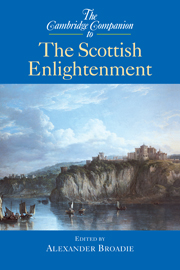Book contents
- Frontmatter
- Introduction
- 1 The contexts of the Scottish Enlightenment
- 2 Religion and rational theology
- 3 The human mind and its powers
- 4 Anthropology: the ‘original’ of human nature
- 5 Science in the Scottish Enlightenment
- 6 Scepticism and common sense
- 7 Moral sense and the foundations of morals
- 8 The political theory of the Scottish Enlightenment
- 9 Economic theory
- 10 Natural jurisprudence and the theory of justice
- 11 Legal theory
- 12 Sociality and socialisation
- 13 Historiography
- 14 Art and aesthetic theory
- 15 The impact on Europe
- 16 The impact on America: Scottish philosophy and the American founding
- 17 The nineteenth-century aftermath
- Select bibliography
- Index
6 - Scepticism and common sense
Published online by Cambridge University Press: 28 May 2006
- Frontmatter
- Introduction
- 1 The contexts of the Scottish Enlightenment
- 2 Religion and rational theology
- 3 The human mind and its powers
- 4 Anthropology: the ‘original’ of human nature
- 5 Science in the Scottish Enlightenment
- 6 Scepticism and common sense
- 7 Moral sense and the foundations of morals
- 8 The political theory of the Scottish Enlightenment
- 9 Economic theory
- 10 Natural jurisprudence and the theory of justice
- 11 Legal theory
- 12 Sociality and socialisation
- 13 Historiography
- 14 Art and aesthetic theory
- 15 The impact on Europe
- 16 The impact on America: Scottish philosophy and the American founding
- 17 The nineteenth-century aftermath
- Select bibliography
- Index
Summary
INTRODUCTION
Scepticism has taken many forms in the history of European thought. Around the middle of the eighteenth century, there were four different versions that were especially significant, two of which were of ancient origin. The first was Pyrrhonian scepticism. It was taken to claim that we have no evidence for any proposition, because any proposition may be contradicted by another proposition of equal probability. Pyrrhonism so understood leads to the suspense of judgement. The second form of scepticism derived from Academic scepticism. The members of the so-called ‘New Academy’ had argued against Pyrrhonism that scepticism cannot be founded on the claim that there are contradictory propositions of equal probability; rather, it is the result of the fact that we can never overcome deception with certainty. The threat of deception, however, did not exclude, for them, the possibility that some judgements are more probable than others: indeed, they thought that we could not live our lives without accepting at least some judgements as being warranted. Thirdly, in his Meditations on First Philosophy (1641) Descartes introduced the idea of methodological doubt as a means to overcome doubts and uncertainties. Descartes argued that knowledge of ourselves was the most fundamental kind of knowledge, and that only things we perceive as clearly and distinctly as the cogito (‘I think, therefore I exist’) can count as true knowledge. A fourth kind of scepticism is related to John Locke, who rejected much of Cartesian metaphysics and especially the concept of innate ideas that was inherent in it. Locke claimed that the faculties of our understanding are very limited indeed.
- Type
- Chapter
- Information
- The Cambridge Companion to the Scottish Enlightenment , pp. 117 - 135Publisher: Cambridge University PressPrint publication year: 2003
- 2
- Cited by



